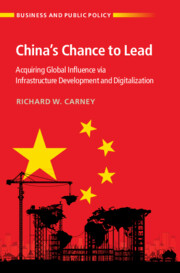Book contents
- China’s Chance to Lead
- Business and Public Policy
- China’s Chance to Lead
- Copyright page
- Dedication
- Contents
- Figures
- Tables
- Preface and Acknowledgements
- Abbreviations
- 1 Introduction
- 2 Market Failures and China’s Chance to Lead
- 3 Measuring Infrastructure Needs and Foreign Infrastructure Investment
- 4 Theory
- 5 Measuring Clientelism and the Corporate Sector across Political Regimes
- 6 Political Regimes and BRI Country-Level Patterns
- 7 Political Regimes and BRI Project Characteristics
- 8 Case Studies of Political Regimes and the BRI
- 9 Chinese Exports of Digital Technologies and Standards
- 10 Conclusions and Implications
- References
- Index
- Business and Public Policy
4 - Theory
Why Countries Vary in Their Participation in the Belt and Road Initiative
Published online by Cambridge University Press: 02 November 2023
- China’s Chance to Lead
- Business and Public Policy
- China’s Chance to Lead
- Copyright page
- Dedication
- Contents
- Figures
- Tables
- Preface and Acknowledgements
- Abbreviations
- 1 Introduction
- 2 Market Failures and China’s Chance to Lead
- 3 Measuring Infrastructure Needs and Foreign Infrastructure Investment
- 4 Theory
- 5 Measuring Clientelism and the Corporate Sector across Political Regimes
- 6 Political Regimes and BRI Country-Level Patterns
- 7 Political Regimes and BRI Project Characteristics
- 8 Case Studies of Political Regimes and the BRI
- 9 Chinese Exports of Digital Technologies and Standards
- 10 Conclusions and Implications
- References
- Index
- Business and Public Policy
Summary
To explain countries’ varying participation in the Belt and Road Initiative, this chapter begins with a discussion of recipient country characteristics that impact the demand for Chinese spending, including the political regime, clientelism, and the public-private orientation of the corporate sector. It then discusses the supply-side factors that influence Chinese foreign spending, including the Chinese Communist Party (CCP), state-owned entities (e.g., SOEs), and private firms. Finally, it evaluates the compatibility of these demand and supply characteristics. The key prediction is that electoral autocracies will display the strongest compatibility with Chinese foreign construction spending. This is amplified when the leaders of these regimes have a weak or insecure hold on power. Electoral autocracies are also predicted to be the most avid adopters of Chinese standards stemming from their eagerness for Chinese infrastructure spending.
Keywords
- Type
- Chapter
- Information
- China's Chance to LeadAcquiring Global Influence via Infrastructure Development and Digitalization, pp. 73 - 107Publisher: Cambridge University PressPrint publication year: 2023

